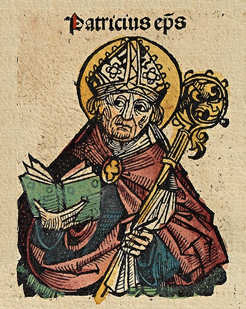 There are many stories and myths that surround St. Patrick, and today we have an entire day based on the legend and continuance of these folk stories. When I thought of St. Patrick one of the first things that came to my mind was the shamrock, a three leaf or four leaf clover. However, when I thought about it I could not pinpoint what I really knew about it, or what it signified. St. Patrick was born in Britain but kidnapped as a teenager and sent to Ireland to tend sheep. St. Patrick later became a bishop and spent the rest of his life trying to convert the Irish to Christianity.
There are many stories and myths that surround St. Patrick, and today we have an entire day based on the legend and continuance of these folk stories. When I thought of St. Patrick one of the first things that came to my mind was the shamrock, a three leaf or four leaf clover. However, when I thought about it I could not pinpoint what I really knew about it, or what it signified. St. Patrick was born in Britain but kidnapped as a teenager and sent to Ireland to tend sheep. St. Patrick later became a bishop and spent the rest of his life trying to convert the Irish to Christianity.  As we have studied in class, Christianity, as defined by the Council of Nicaea (325 C.E.), was at its very basic form. The trinity was agreed upon, even though it might not have been easy to explain. The legend of St. Patrick says one day he had followers that came to him and said they were having a difficult time believing the concept of the trinity. St. Patrick in all his wisdom thought about it, bent down and picked up a shamrock, and used the one leaf that had three parts to explain the Holy Trinity. This story has been passed down through the ages and that is why St. Patrick is often seen holding a shamrock.
As we have studied in class, Christianity, as defined by the Council of Nicaea (325 C.E.), was at its very basic form. The trinity was agreed upon, even though it might not have been easy to explain. The legend of St. Patrick says one day he had followers that came to him and said they were having a difficult time believing the concept of the trinity. St. Patrick in all his wisdom thought about it, bent down and picked up a shamrock, and used the one leaf that had three parts to explain the Holy Trinity. This story has been passed down through the ages and that is why St. Patrick is often seen holding a shamrock.
Resources
Humphrey, Lauren. “Saint Patrick and the Druids: A Window into Seventh-Century Irish Church Politics.” Medievalists.net, 31 May 2012,
Roach, John. “St. Patrick's Day Facts: Shamrocks, Snakes, and a Saint.” National Geographic, National Geographic Society, 18 Mar. 2010, news.nationalgeographic.com/news/2010/03/100316-st-patricks-day-facts-shamrocks/
“The Legend of the Shamrock.” Irish Indeed, www.irishindeed.com/legend-of-the-shamrock/



Good image on bottom right.
ReplyDeleteAnd love the title!
ReplyDelete